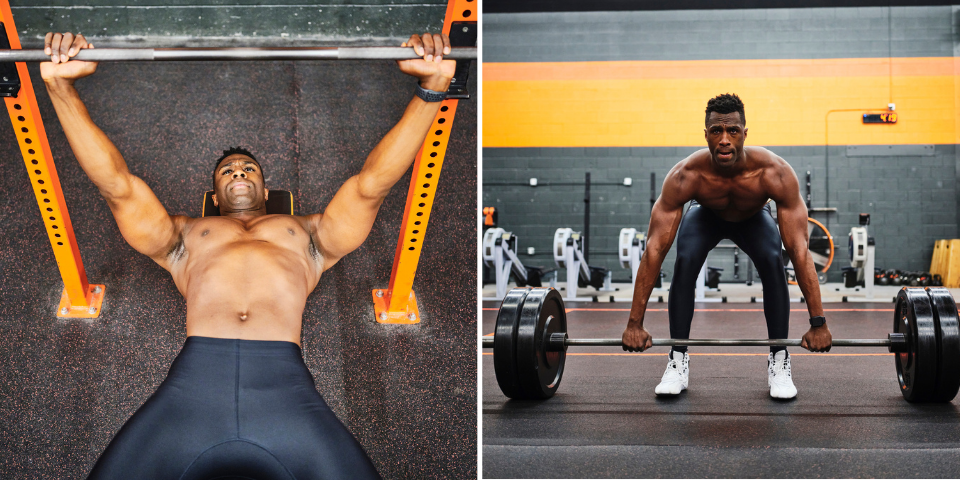If you’re chasing specific fitness results, you may wonder whether working out twice a day will help you achieve them twice as fast. Once a relic of high school sports training, two-a-day workouts are now all over social media and are even included in some popular lifestyle programs. But should two-a-days be part of your workout routine? Does working out twice a day double the payoff or double the risk?
Are There Benefits to Working Out Twice a Day?

When it comes to the advantages of two-a-day workouts, “there really aren’t any unless you’re an elite athlete,” says Trevor Thieme, CSCS. “If you have enough gas in the tank to tackle two daily workouts, you likely aren’t going hard enough in either one to optimize your progress toward your goals.”
To be clear, that doesn’t mean that you should never work out more than once a day. “If you’re too busy to complete your whole workout all at once on some days, go ahead and split it up,” Thieme says.
You can also perform some moderate-intensity cardio on the same day as strength training, or vice versa — though you’d probably be better off doing them on different days altogether if you’re serious about endurance and/or strength gains.
But “divide and conquer” isn’t your only option when you’re pressed for time. “You should also consider doing a higher-intensity, shorter workout rather than a longer one split into two parts,” Thieme suggests. “When you get right down to it, workout density trumps workout duration.”
What Are the Cons of Two-a-Day Workouts?
Unless you’re splitting one workout into two parts to accommodate your schedule, working out twice a day is more likely to hold back your progress than hasten it.
1. Increases your risk of overtraining
In order to adapt to the training stimuli provided by your workouts, your body needs sufficient time to recover between them. “Pushing yourself too hard too often can put you on the fast track to overtraining,” warns Thieme. “That can not only land you in a training rut, but also increase your risk of injury.”
2. Decreases physical performance
Burnout caused by overtraining will include a decrease in your performance during workouts. What’s worse, the effects of overtraining can spill into your everyday life, and include mood swings, insomnia, and loss of appetite.
3. Negatively affects muscle growth
Building muscle mass is a process of creating micro-damage in your muscles, which triggers repair and adaptation processes that leave you stronger and fitter than before. But overtraining impedes muscle repair, recovery, and growth. If you’re not building muscle effectively, you’ll have a more challenging time reaching your goals.
Should Beginners Work Out Twice a Day?

In general, it’s not advised for beginners to work out twice a day. “There’s almost no reason to do two-a-days,” says Thieme. “Besides, most people have trouble finding time to do one workout a day, let alone two.”
When you’re just starting out, focus on being consistent, not overzealous. Adding a second workout to your day can actually hinder your goals.
Thieme explains that beginners are at the same risk of overtraining as everyone else. That’s because overtraining “occurs when you push yourself too hard, too often for your fitness level, whatever that fitness level is. No matter what your fitness level is, overtraining will put the brakes on your gains and increase your risk of injury.”
3 Ways to Reach Your Goals Faster
“When it comes to fitness, more isn’t necessarily better,” says Thieme. Instead of working out twice a day, consider the following training ideas, so you can train smarter, not harder, to achieve your goals faster.
1. Focus on workout quality, not duration
How long you work out is far less important than how you work out. “As long as your workouts are aligned with your fitness objectives and you challenge yourself multiple times a week, you will reach your goals,” he says.
2. Prioritize rest
Rest days are just as important as your workouts, and you should prioritize them. Even if you’re already taking rest days from the gym, you should watch for signs of overtraining like increased fatigue, sleeplessness, reduced athletic performance, mood changes, and a decline in motivation.
If you notice any of these symptoms, it’s time to dial back your training volume and intensity and dial in your post-workout recovery until your performance is back on track.
3. Increase your daily activity level
A daily workout doesn’t counterbalance an otherwise sedentary lifestyle. That’s why it’s essential to become more active in general.
“Focus on increasing your non-exercise activity thermogenesis (NEAT), which is all of the calories you burn throughout the day outside of exercise,” says Thieme. “If your goal is weight loss, or even if it’s just being healthier overall, you need to give NEAT just as much attention as working out.”
